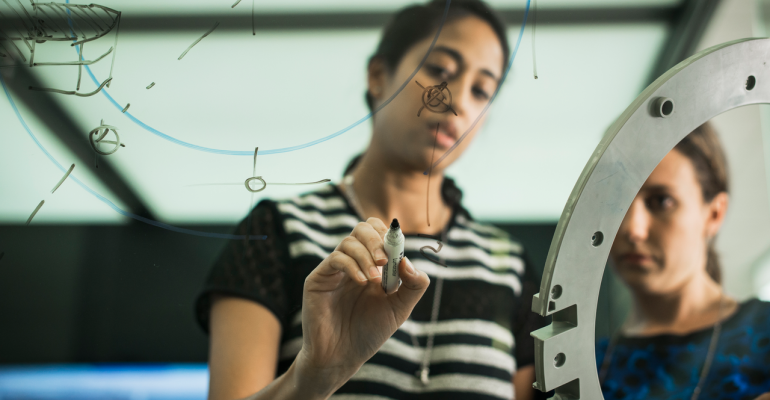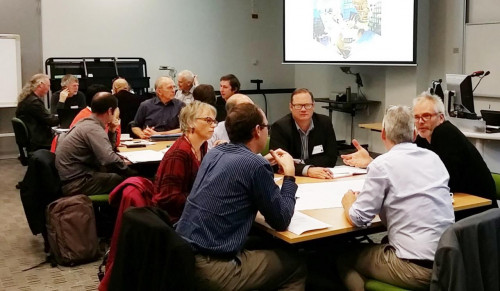Building New Zealand’s innovation capacity
This longitudinal research programme continues over the lifetime of SfTI, examining human capacity (soft skills), and relational capacity (networking skills), within New Zealand’s innovation system.

Team
Spearhead co-leader, Dr Katharina Ruckstuhl, Ngāi Tahu Rangitāne. University of Otago – Leader, Māori innovation, Mātauranga Māori, Māori Small Business
Spearhead co-leader, Professor Urs Daellenbach – Te Herenga Waka-Victoria University of Wellington - Management, Wellington School of Business & Government
Snapshot
This unique study is evaluating how Science for Technological Innovation (SfTI) researchers and external stakeholders collaborate on projects with the resulting insights capable of boosting innovation performance.
The aim is to understand what works best in the New Zealand context, evaluate the effectiveness of our work, and learn from it as we go.
Research results are continuously fed back, allowing SfTI leadership and the science system in general, to learn from the research team’s findings.
International benchmarking will compare SfTI innovation processes and management to best practice around the world.
The research represents the first significant examination of how researchers and Māori businesses or organisations interact, and how cultural capacity is built in the innovation ecosystem.
Getting New Zealand’s innovation ecosystem firing
New Zealand continues to lag many other OECD countries when it comes to investment in research and development and the Government has sought to foster a more productive and cohesive innovation ecosystem as a result.
While increased spending on fundamental and applied research in the public sector and private businesses respectively is considered by experts to be part of the solution, research suggests that human and relational capacity – the skills and attributes our researchers have and their ability to work in productive networks, may be as important to shifting the needle on innovation output.
Science for Technological Innovation (SfTI) National Science Challenge researchers are literally putting that to the test, examining how researchers and industry partners interact across all of SfTI’s projects over a ten-year period.
The project constitutes the first long-term study of its kind undertaken in the New Zealand research system, and is even more significant because it looks at how cultural capacity – how appropriate ways of collaborating with Māori organisations, may also enhance human capacity.
Measuring capacity to innovate – how does it work?
The research is based on the ‘open innovation’ concept, which is testing the belief that value enterprises need to acquire, assimilate and exploit knowledge from internal resources, as well as seeking out external sources.
The capacity of New Zealand’s research groups to connect with the companies, industry and Māori organisations that can help commercialise their science and innovation, isn’t particularly well understood.
This Spearhead project looks to offer new insights through observational studies and real-time case studies examining the efficacy of the SfTI’s research processes and industry engagement. Since the Māori economy has distinctive features, parallel case-studies of co-innovation projects between SfTI researchers and Māori organisations are included in the project.
Research findings will be shared with the wider science community on an ongoing basis, so that the innovation ecosystem can learn from SfTI’s work.

So how is the project tracking?
Phase one of the Spearhead project, which is led by Dr Katharina Ruckstuhl from the University of Otago and Dr Urs Daellenbach from Victoria University of Wellington, saw the team attempt to identify the human and relational enablers and barriers to engagement between researchers and industry that exist in New Zealand.
This took an ‘inside-out’ perspective, drawing on observations and surveys involving seven SfTI Spearhead projects and 34 Seed projects including around 300 researchers.
The early research revealed that while SfTI researchers are open to engaging with industry at certain stages of their research, interventions from SfTI science leadership were key to the extent and timing of this interaction.
Surveying of SfTI researchers established their baseline attitudes, behaviours and capacities, which will be re-evaluated during the course of the SfTI research programme to evaluate how they change as research progresses through different stages.
Phase one also saw the team feed that suggestions to the SfTI Programme Office, to allow refinements in research management processes, a practice that will continue throughout the life of the project.
Three initial surveys of businesses were undertaken to better understand their innovation productivity, use of human and social capital (especially cooperation with science research) and their ‘absorptive capacity’ – their ability to identify and utilise external R&D, knowledge/mātauranga.
Phase one Insights report
The insights relate to four key areas:
1. Building openness is the key to collaborative innovation
2. Intermediaries are key catalysts of Vision Mātauranga
3. Success requires building the collaborative capacity of stakeholders
4. Ongoing communication brings the greatest benefit to collaboration
What’s next in Phase two (2019-2024)?
The team will continue to assess the engagement that occurs between researchers and industry across SfTI projects to observe how behaviour changes and to ascertain if any enhancements are specific to SfTI-funded research or can apply across the innovation ecosystem.
Phase two will extend selectively some key investigation areas from Phase one, but add new analysis of more recent interventions applied to the more recently-formed Spearhead projects. The focus will broaden to the external partner side of engagement in New Zealand science and engineering research.
Longitudinal Science Team Tracking (LSTT) will evaluate the impact of SfTI process innovations that took place during Phase one, including whether they accelerated collaborative R&D processes.
SfTI’s innovation management processes will be evaluated and benchmarked against comparative national and international innovation management measures.
This will encompass everything from project selection and team formation processes to the role of sci-tech intermediaries (such as business advisors and Kāhui Māori), as well as capacity development related to Vision Mātauranga, leadership and commercialisation.
A stream of research will look specifically at engagement by industry and Māori with science and engineering for innovation. It will draw on international innovation management studies, multiple surveys and in-depth qualitative assessments to identify potentially NZ-specific engagement barriers and identify better ways of doing things.
Phase two Insights report
Building New Zealand’s Capacity for Science-based Open Innovation Report 2022 identifies four trends that accelerate innovation:
Trend one: Moving beyond Traditional Science
This trend suggests innovation is accelerated when collaboration with non-scientists is promoted. This is done through a mission led approach to team design and the use of ‘innovation intermediaries’ to connect people throughout the innovation journey.
Trend two: Opening Science for Open Innovation
Open innovation is a shift from more traditional and competitive closed practices. This collaborative approach involves finding ways to navigate the limits of intellectual property (IP) concerns and other barriers to open information sharing.
Trend three: Opening Science for Māori Innovation
The Māori economy is a huge opportunity and strength for Aotearoa’s science system. Supporting innovation means finding ways to open up the science system for mātauranga Māori and Māori scientists. This is promoted via removing barriers such as the current disproportionate weight of work on Māori scientists, concerns over ownership and use of Māori data and the need for ‘Māori non-scientist matchmakers’.
Trend four: Developing entrepreneurial behaviours
This trend involves providing support for scientists to develop the skills and capacity to collaborate well and make long term and authentic connections.
A unique approach to increase innovation
This project is an unprecedented effort in New Zealand to understand how researchers and industry work together to innovate – and to point the way forward for more productive collaboration that could boost our collective R&D efforts.
It uses SfTI’s own research projects as a window into the innovation process, constantly analysing progress and feeding back insights to SfTI leadership, and the wider innovation ecosystem.
In this way, the benefits of the project are being felt well before its conclusion. In particular, the project has the potential to enhance the Māori economy, by undertaking the first significant analysis of the interaction between New Zealand’s physical science and engineering researchers and Māori businesses.
As this project progresses, its researchers will continue their quest to identify the critical factors at an individual researcher level, at an organisational and within the science system more broadly, that will allow New Zealand to unlock the real potential in its innovation ecosystem.
Project background information
This Spearhead project came about at the suggestion of the MBIE Science Panel in the early stages of the SfTI National Science Challenge (NSC). Given the importance of SfTI's mission to enhance the capacity of Aotearoa-New Zealand to use physical sciences and engineering for economic growth and prosperity, the project was considerably expanded in the proposal development phase. With the aim of designing a specific research project to study SfTI’s approach to mission-led research and capacity development processes, the cross-disciplinary research team consists of 50% Vision Mātauranga innovation researchers.